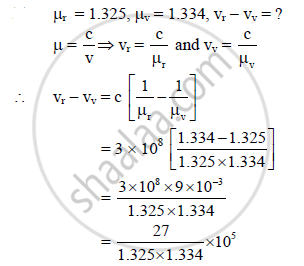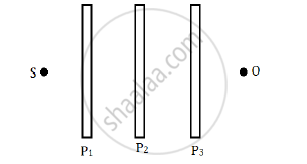Advertisements
Advertisements
Question
The refractive indices of water for red and violet colours are 1.325 and 1.334 respectively.
Find the difference between the velocities of rays for these two colours in water. (c = 3 × 108 m/s)
Solution

= [log (27) − log (1.325) − log (1.334)] × 105
= [1.4314 − 0.1222 − 0.1252] × 105
= [antilog (1.184)] × 105
= 15.28 × 105 = 1.528 × 106 m/s.
The difference between the velocities of rays for red and violet colours in water is
1.528 × 106 m/s.
APPEARS IN
RELATED QUESTIONS
If the polarising angle for a given medium is 60°, then the refractive index of the medium is.................
Draw a neat labelled diagram showing the plane of vibration and plane of polarisation for polarised light.
If the critical angle of a medium is sin-1(3/5), find the polarising angle.
Three identical polaroid sheets P1, P2 and P3 are oriented so that the pass axis of P2 and P3 are inclined at angles of 60° and 90° respectively with the pass axis of P1. A monochromatic source S of unpolarised light of intensity I0 is kept in front of the polaroid sheet P1 as shown in the figure. Determine the intensities of light as observed by the observer at O, when polaroid P3 is rotated with respect to P2 at angles θ = 30° and 60°.

Why does an unpolarised light incident on a polaroid get linearly polarised ?
How does one demonstrate, using a suitable diagram, that unpolarised light when passed through a Polaroid gets polarised?
Show, with the help of a diagram, how unpolarised sunlight gets polarised due to scattering.
Unpolarised light is passed through a polaroid P1. When this polarised beam passes through another polaroid P2 and if the pass axis of P2 makes angle θ with the pass axis of P1, then write the expression for the polarised beam passing through P2. Draw a plot showing the variation of intensity when θ varies from 0 to 2π.
Show using a proper diagram how unpolarised light can be linearly polarised by reflection from a transparent glass surface.
Green light is incident at the polarising angle on a certain transparent medium. The angle of refraction is 30° . Find
(i) polarising angle, and
(ii) refractive index of the medium.
A ray of light is incident on a transparent medium at a polarizing angle. What is the angle between the reflected ray and the refracted ray?
What is the difference between polarised light and unpolarised light?
A ray of ordinary light is travelling in air. It is incident on air glass pair at a polarising angle of 56°. Find the angle of refraction in glass.
Explain how an unpolarised light gets polarised when incident on the interface separating the two transparent media.
Greenlight is an incident at the polarising angle on a certain transparent medium. The angle of refraction is 30°.
Find
(i) polarising angle, and
(ii) refractive index of the medium.
What is a polariser?
What is a analyser?
What is plane polarised light?
List the uses of polaroids.
An unpolarised light of intensity 32 Wm-2 passes through three Polaroids such that the axes of the first and the last Polaroids are at 90°. What is the angle between the axes of the first and middle Polaroids so that the emerging light has an intensity of only 3 Wm-2?
The reflected light is found to be plane polarised when an unpolarized light falls on a denser medium at 60° with the normal. Find the angle of refraction and critical angle of incidence for total internal reflection in the denser to rarer medium reflection.
A plane mirror produces a magnification of
Can reflection result in plane polarised light if the light is incident on the interface from the side with higher refractive index?
For the same objective, find the ratio of the least separation between two points to be distinguished by a microscope for light of 5000 Å and electrons accelerated through 100 V used as the illuminating substance.
A polarizer - analyser set is adjusted such that the intensity of light coming out of the analyser is just 10% of the original intensity. Assuming that the polarizer - analyser set does not absorb any light, the angle by which the analyser need to be rotated further to reduce the output intensity to be zero, is ______.
